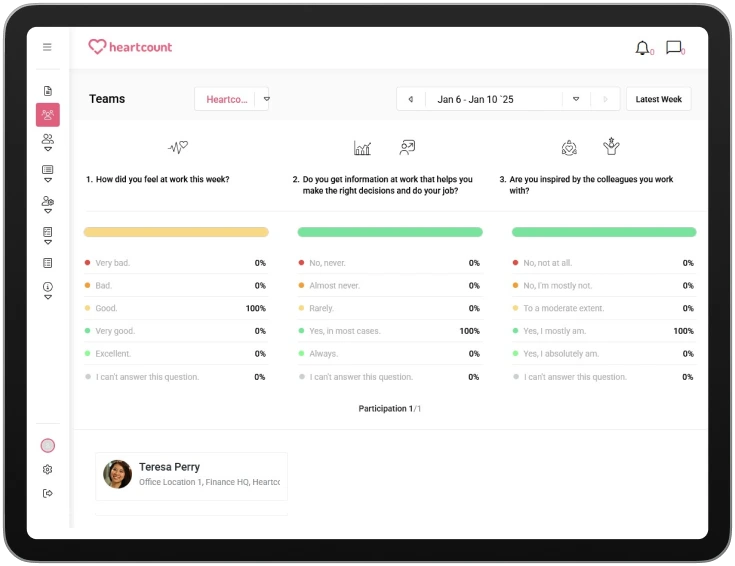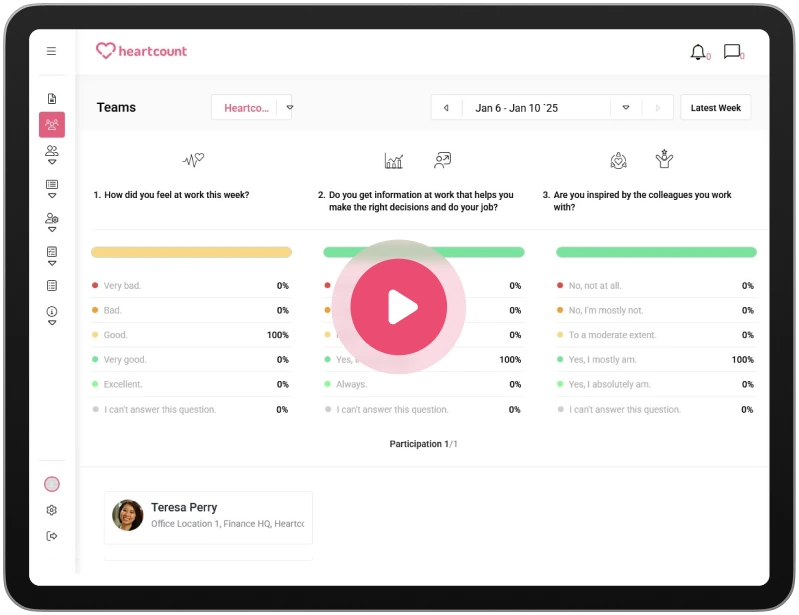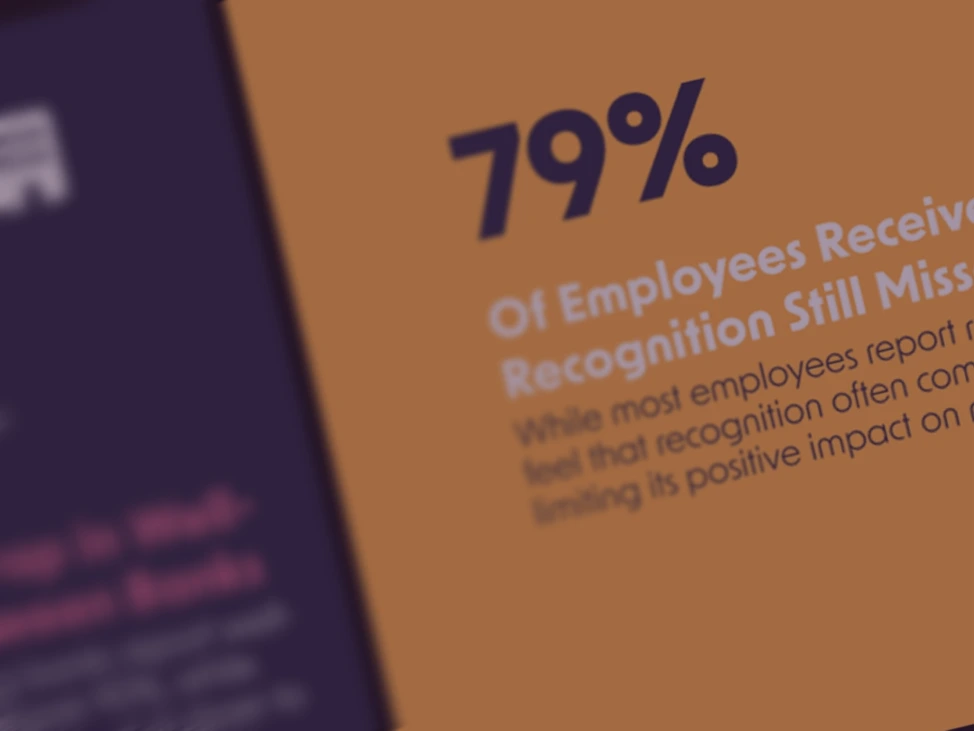How to Improve Employee Sentiment: From Data to Action

Employee sentiment directly impacts engagement, retention, and your company’s success. But getting a clear picture of that sentiment can be a struggle.
HR professionals often face challenges such as:
- Lack of clear data
- Finding root causes of dissatisfaction
- Turning data into actions
- Limited resources for deep analysis
- Getting honest feedback from employees who fear repercussions
In this article, you will learn what employee sentiment is, why it matters, and how it affects employee engagement and job satisfaction. We also explain how to effectively measure and improve employee sentiment.
-
1.What is employee sentiment?
-
2.Why is employee sentiment important?
-
3.What are the key drivers of employee sentiment?
-
4.Importance of measuring employee sentiment
-
5.What is an employee sentiment survey?
-
6.What is an employee sentiment score?
-
7.What is employee sentiment analysis, and why is it important?
-
8.How to measure employee sentiment?
-
9.Best practices for measuring employee sentiment
-
10.Hearts are what counts
Employee sentiment directly impacts engagement, retention, and your company’s success. But getting a clear picture of that sentiment can be a struggle.
HR professionals often face challenges such as:
- Lack of clear data
- Finding root causes of dissatisfaction
- Turning data into actions
- Limited resources for deep analysis
- Getting honest feedback from employees who fear repercussions
In this article, you will learn what employee sentiment is, why it matters, and how it affects employee engagement and job satisfaction. We also explain how to effectively measure and improve employee sentiment.
What is employee sentiment?
Employee sentiment shows how your employees feel about their job and workplace. More importantly, it explains why they feel the way they do. It includes a range of emotions and opinions that can be positive, negative, or neutral.
- Positive sentiment: Satisfaction, happiness, enthusiasm, motivation, loyalty.
- Negative sentiment: Stress, frustration, disappointment, and disengagement.
- Neutral sentiment: Indifference, apathy, uncertainty, and conditional opinions.
Key aspects of employee sentiment include:
- Job satisfaction: How happy employees are with their job.
- Engagement: How enthusiastic and committed they are to their work.
- Work-life balance: How well they can manage work and personal life.
- Management relations: How they feel about their bosses and leaders.
- Organizational culture: How they perceive the company’s values and atmosphere.
- Career development: Opportunities for growth and advancement.
Why is employee sentiment important?
Employee sentiment is important because it impacts productivity, retention, and workplace morale.
Positive employee sentiment can bring your company:
- Higher efficiency: Employees who feel good about their work environment perform well. Higher performance levels contribute to achieving organizational goals and improving business outcomes.
Engaged employees increase:- Productivity by 14%
- Customer ratings by 10%
- Sales by 18%
- Profitability by 23%
- Organizational participation by 13%
- Reduced employee turnover costs: Companies with positive employee sentiment have 59% less turnover. Reducing turnover keeps top talent and saves the costs of new hires. This is especially important considering these costs range from 33% to 200% of the departing employee’s salary.
- Improved loyalty: Positive sentiment fosters loyalty and commitment, reducing absenteeism. Engaged employees are less likely to take unnecessary sick days, leading to consistent productivity. In fact, Gallup’s study found that companies with high engagement see 81% less absenteeism and 14% more productivity, highlighting the direct link between sentiment and attendance.
- Increased profitability: Companies with a happy, engaged workforce see significant financial benefits. They usually exceed their peers by 147% in earnings per share. Their employees take initiative, go beyond basic job duties, and contribute more to the company’s success.
- Stronger company culture: Positive employee sentiment adds to a supportive and collaborative company culture, which helps with talent management. Employees unsatisfied with their company’s culture are 24% more likely to leave their jobs.
- More innovation and creativity: Employees who feel valued are more likely to take responsibility for their duties and be inspired to promote innovation, which can help a company stand out from the competition.
- Better customer service: Happy employees provide better customer service, which leads to higher customer satisfaction and loyalty. 73% of customers feel connected and stay loyal to a brand with friendly customer care representatives.
How does employee sentiment impact employee engagement?
Employee sentiment boosts engagement and retention by increasing motivation, job satisfaction, and performance. It influences:
- Employee Net Promoter Score (eNPS): Measures the likelihood of employees recommending the workplace to others. Employees with positive sentiments are likelier to recommend their workplace to others. A higher eNPS indicates a strong, engaged workforce willing to promote the company as a great place to work.
- Participation rate in engagement programs: Tracks employee involvement in company-sponsored activities. When employees feel valued and engaged, their positive sentiment leads to higher participation rates. Negative sentiment can result in low participation rates.
- Voluntary turnover rate: Employees who feel appreciated and engaged are less likely to leave the company voluntarily. This stability helps maintain continuity and reduces the costs of hiring and training new employees.
- Task completion rate: Monitors the percentage of tasks completed on time, reflecting employee motivation and engagement. Positive sentiment typically boosts motivation and commitment, resulting in timely task completion. Negative sentiment can lead to procrastination, lower productivity, and delays in task completion.
- ROI on employee engagement: Happy and engaged employees contribute to higher productivity and profitability, justifying investments in engagement initiatives.
How does employee sentiment impact employee well-being?
Employee sentiment impacts all segments of employees’ well-being. This includes mental and physical health, work-life balance, job satisfaction, and more.
Positive employee sentiment improves employee well-being metrics:
- Employee health index: Evaluates overall employee health through health screenings and surveys. Employees with positive sentiments are generally healthier, as they experience less stress and have better mental health.
- Work-life balance score: Assesses employees’ satisfaction with balancing work and personal life. Positive sentiment is enhanced when employees have a good work-life balance. Negative sentiment arises when employees feel overworked and unable to balance personal and professional lives.
- Stress levels: Measures employee stress through surveys or physiological indicators. Positive sentiment helps reduce stress levels, as employees feel supported and content. High stress levels often indicate negative sentiment, reflecting dissatisfaction and burnout.
- Access to well-being resources: Tracks how effectively employees can access mental and physical health resources. When employees have positive sentiments, they are more likely to use well-being resources provided by the company. These resources typically include counseling, fitness and nutrition support, flexible work arrangements, etc.
- Absenteeism rates: Employee sentiment directly affects absenteeism. Positive sentiment leads to lower absence rates as employees are more motivated to attend work and less likely to take unnecessary sick days. Conversely, negative sentiment can increase absenteeism due to disengagement, stress, or dissatisfaction.
Less than two-thirds of workers rate their physical and mental well-being as excellent (63%) or good (58%). Percentages for social (45%) and financial well-being (35%) are even lower. Additionally, work stress costs U.S. employers $300 billion a year, affecting performance and absenteeism.
Improving employee sentiment can ease stress, leading to a healthier, more productive workforce.
How does employee sentiment impact employee satisfaction?
Employee sentiment impacts employee satisfaction by influencing how employees feel about their work environment, relationships, and organizational culture.
Positive sentiment typically leads to higher job satisfaction, increased engagement, and a greater sense of well-being. Conversely, negative sentiment can result in dissatisfaction, decreased motivation, and higher turnover rates.
Employee sentiment affects:
- Job satisfaction score: Gauges overall contentment with job roles and responsibilities. Positive sentiment leads to higher job satisfaction as employees feel fulfilled and appreciated. Negative sentiment results in low job satisfaction, indicating dissatisfaction with job roles and responsibilities.
- Compensation and benefits satisfaction: Assesses satisfaction with pay and benefits packages. Fair and competitive compensation contributes to positive sentiment and job satisfaction.
- Career development opportunities: Evaluates satisfaction with professional growth and advancement opportunities. Positive sentiment increases when employees see clear paths for growth and development. Negative sentiment occurs when employees stagnate and lack opportunities for advancement.
- Work environment satisfaction: Measures satisfaction with the physical and social work environment. A positive and supportive work environment enhances overall employee sentiment.
- Recognition and rewards: Assesses how appreciated employees feel for their contributions. Positive sentiment is boosted when employees feel recognized and rewarded for their contributions. Lack of recognition leads to negative sentiment, making employees feel undervalued.
- Management and leadership effectiveness: Evaluates satisfaction with the quality and effectiveness of management. Positive sentiment is driven by effective and supportive leadership. Negative sentiment can stem from poor management practices, leading to dissatisfaction and a lack of trust in leadership.
COLLECT
What are the key drivers of employee sentiment?
1. Supportive leadership and management
The quality of leadership and management practices greatly impact employee sentiment.
Supportive and transparent leadership fosters trust, respect, and a positive outlook among employees. Leaders who show empathy and provide guidance create a stable and encouraging environment. Employees who trust their leaders feel secure and satisfied, which improves overall sentiment.
A Harvard Business study confirms that trust in leadership is essential for a successful organization. Employees at high-trust companies report less stress, more energy, and higher productivity than those at low-trust companies. Leaders build trust by fostering a safe and transparent environment, acting authentically, and following through on commitments.
You improve leadership in your company through:
- Frequent and open communication
- Regular acknowledgement
- Professional development opportunities
- Work-life balance support
- Empathy
- Consistent feedback and coaching
2. Recognition and appreciation
Employees need to feel validation for their contributions. Regular recognition and rewards boost morale and make employees feel acknowledged and motivated.
You can do it through:
- Verbal praise
- Bonuses
- Public acknowledgment
Recognizing employees’ hard work helps maintain high morale and encourages continued excellence.
International Journal of Science and Research (IJSR) study found a direct and positive relationship between recognition programs and employee satisfaction and motivation. It highlights that recognition can be a powerful tool for leaders to improve employee morale and overall performance.
3. Work-life balance
Balancing professional and personal life is essential for employee well-being. Companies can support this by offering:
- Flexible hours
- Remote work options
- Paid time off
- Employee wellness programs
- Family leave policies
When employees manage private and professional areas well, they are less stressed. This leads to higher productivity and loyalty.
Chartered Institute of Personnel and Development (CIPD) investigated the impact of work-life balance programs on employee well-being. The research found that offering flexible work arrangements (like remote work or flexible hours) and increased perceptions of supportive management were the key factors in improved well-being rather than simply reducing work hours.
This suggests that feeling in control of workload and having supportive leadership may be even more important for reducing stress and improving well-being than simply reducing work hours.
4. Job security
Feeling secure in one’s job is a fundamental need for employees.
Job security reduces anxiety and stress, creating a positive view of the company. Employees who feel that their jobs are stable and valued are more engaged and committed, leading to lower employee turnover and higher morale.
You can make employees feel more secure about their jobs through:
- Transparent communication about company stability and future plans
- Fair hiring, evaluation, and promotion practices
- Career development opportunities.
- Acknowledgement and rewards for employee contributions.
- Regular performance feedback and support for improvement
The study Job Security and Employee Well-Being: Evidence from Matched Survey and Register Data, published in Labour Economics, demonstrates that job security enhances employee well-being. Secure employees experience reduced anxiety and stress, improving mental health and overall life satisfaction.
They also report higher job satisfaction, increased engagement, and greater commitment to their organization, which boosts productivity. The study suggests that policies that promote job security can lead to a healthier, more satisfied, and more productive workforce.
5. Career development opportunities
Opportunities for growth and development boost employee engagement and satisfaction. Employees who see a future within the company feel more positive and motivated.
Key means of advancement include:
- Training programs
- Promotions
- Mentorship
- Skill development workshops
- Career advancement prospects
- Certifications
- Conferences and seminars
Employees stay loyal and motivated when their employer invests in their growth.
Professional Development Opportunities and Job Satisfaction: A Systematic Review of Research analyzed various studies on the connection between professional development and job satisfaction. The research found a strong positive correlation between the two. Employees with access to training programs, skill development opportunities, and career advancement prospects report higher job satisfaction and engagement levels.
6. Work environment and culture
An inclusive and supportive work culture improves employees’ feelings about their jobs. Employees feel valued and part of a community when the workplace is comfortable and safe, and the culture is healthy. This sense of belonging boosts their overall sentiment and satisfaction at work.
You can achieve an inclusive and supportive work culture through:
- Diversity and inclusion initiatives, such as training programs and employee resource groups
- Safe and comfortable workplace
- Team-building activities
- Open-door policy
- Respectful interactions among colleagues
A Review on the Impact of Workplace Culture on Employee Mental Health and Well-Being found that a positive workplace culture significantly improves mental health and well-being.
Supportive leadership, social support, balanced job expectations, and work-life balance are key factors. Conversely, a toxic culture with poor leadership and high job demands harms mental health.
7. Compensation and benefits
Adequate pay and benefits contribute to positive sentiment. They make employees feel rewarded for their work.
Key elements include:
- Competitive salaries
- Health insurance
- Retirement plans
- Performance bonuses
- Paid time off
- Employee wellness programs
These perks reduce financial stress and increase loyalty.
Corestream survey found that 76% of employees would be more likely to stay at their current jobs if they offered better benefits. This statistic highlights the importance of competitive compensation and benefits in attracting and retaining employees.
It suggests that employees who feel financially secure and well-looked-after by their company experience a more positive sentiment towards their work.
8. Communication and transparency
Open and transparent communication from management builds trust and clarity.
To foster a culture of transparent communication:
- Inform employees regularly
- Value and act on their feedback
- Communicate company goals and policies
- Maintain open channels for input
- Build a positive, inclusive culture
Employees who feel their voices are heard are 4.6 times more likely to make a positive impact. This statistic highlights the connection between open communication and employees’ willingness to go the extra mile for their company.
9. Job role and responsibilities
Clarity in job roles and the right level of autonomy affect how employees feel about their work.
Well-defined roles, autonomy, and responsibility foster a sense of purpose and positive sentiment. When employees understand their tasks, they are more engaged.
Feeling empowered to make decisions increases their job satisfaction.
To ensure everyone comprehends their roles:
- Provide clear job descriptions
- Conduct regular check-ins
- Delegate authority
- Offer guidance and support without micromanaging
- Motivate employees to be proactive in their tasks
The study by Permata and Mangundjaya found that job autonomy improves work engagement, promoting proactive work behavior among employees. Using data from 208 employees in Indonesia, the research showed that while job autonomy alone doesn’t directly lead to proactive behavior, it does so indirectly through increased work engagement.
This highlights the importance of fostering employee engagement to make the most of their autonomy and encourage proactive actions, which are vital for organizational sustainability.
10. Peer relationships
Relationships with colleagues and the sense of camaraderie influence job satisfaction.
Strong, positive relationships with peers create a supportive and enjoyable work environment. Employees with friends at work are more engaged, productive, and innovative.
Collaborative and friendly interactions create a sense of community and belonging. This is essential for maintaining high morale.
You can encourage peer relationships through:
- Team building activities
- Mentorship programs
- Social events
- Team project and cross-functional collaboration
Wildgoose’s Workplace Friendship & Happiness Survey discovered that 58% of employees consider happiness in a workplace more important than salary. Also, 57% of respondents said having a good friend at work makes their job more enjoyable.
11. Health and well-being initiatives
Programs that support physical and mental health contribute to well-being:
- Employee wellness programs
- Mental health support
- Ergonomic workplaces
- Fitness memberships
- Nutrition counseling
- Stress management resources
- Health screenings
- Flexible work schedules
These initiatives improve health and employee sentiment and show that the company cares about its employees’ well-being.
A 2023 McKinsey Health Institute survey involving over 30,000 employees in 30 countries revealed a correlation between positive work experiences and employee well-being.
Employees who reported feeling good about their work environments also exhibited better holistic health, increased workplace innovation, and improved job performance.
12. Corporate Social Responsibility (CSR)
Employees are proud to work for socially responsible companies. CSR initiatives improve sentiment by aligning company values with personal values. Examples include:
- Community service projects
- Environmental sustainability programs
- Charity donations
- Volunteer opportunities
- Ethical sourcing practices
Employees feel proud to be a part of a company that supports social and environmental causes.
A study by Nnamdi Ugo Joseph found that CSR boosts employee engagement and organizational performance. The review showed that CSR practices improve job satisfaction and commitment, leading to higher productivity and customer satisfaction. Companies with strong CSR initiatives also see better financial results and brand reputation.
Importance of measuring employee sentiment
Measuring employee sentiment provides a window into your company’s health.
Measuring employee sentiment lets you:
- Identify issues timely and prevent them from escalating and affecting productivity and morale
- Use strategies that boost employee engagement, such as:
- Offering flexible working hours
- Recognizing and rewarding employee contributions
- Providing career development opportunities
- Improving communication channels.
- Improve employee retention and reduce hiring and training costs
- Boost productivity, as happy and engaged employees are more committed to their work
- Reduce absenteeism and ensure consistent productivity
- Create a positive, inclusive, and collaborative work culture
- Improve physical and mental health outcomes, reducing healthcare costs for the organization.
What is an employee sentiment survey?
An employee sentiment survey is a tool companies use to understand how employees feel about their work. It gathers feedback on different aspects of the job that impact employee satisfaction.
These surveys can include various topics, for example:
- Job satisfaction: How employees feel about their tasks and growth opportunities
- Company culture: Views on the work environment and leadership
- Work-life balance: Ability to manage work and personal life
- Compensation and benefits: Satisfaction with pay and perks
- Communication: Effectiveness of information sharing in the organization
You should always keep employee sentiment surveys anonymous or confidential to allow the workforce to express their honest opinions without fear.
Analyzing sentiment data, you’ll identify trends, patterns, and areas for improvement. These surveys help you understand employee needs and bring informed decisions to create a positive work environment.
UNDERSTAND
What is an employee sentiment score?
An employee sentiment score is a number that represents employees’ feelings based on feedback data. It combines data from surveys, interviews, and sentiment analysis tools into one metric.
To calculate an employee sentiment score, assign a value (often on a scale of 1 to 5) to different response options.
For example, one is Strongly Disagree, and five is Strongly Agree. The average of these values across all responses provides a basic sentiment score.
Calculating and monitoring an employee sentiment score is beneficial for:
- Identifying trends in employee satisfaction. A declining score might mean emerging issues.
- Comparing your score to industry averages to see how your company stands in terms of employee well-being.
- Guiding action toward areas for improvement. A low work-life balance score might prompt initiatives to promote better boundaries.
What is employee sentiment analysis, and why is it important?
Employee sentiment analysis is a method that uses data analytics and natural language processing (NLP) to understand employees’ emotions, attitudes, and opinions.
It collects feedback from surveys, emails, chat logs, and social media posts and further processes it to gauge employee sentiment.
Employee sentiment analysis provides HR departments with valuable insights into employees’ thoughts and feelings, which can uncover key areas for improvement. These insights enable HR reps to identify factors influencing employee engagement, productivity, and retention. They can develop targeted strategies to address issues and foster a positive work environment by understanding sentiment trends.
For example, if sentiment analysis reveals dissatisfaction with management communication, HR can implement training programs to improve leadership skills.
Or, if employee sentiment analysis detects high stress levels, HR can introduce wellness programs or flexible work arrangements to alleviate pressure and improve well-being.
ACT
How to measure employee sentiment?
Measuring employee sentiment illustrates how employees feel about their work and the company. The best methods you can leverage to capture sentiment data include:
Employee surveys
Employee engagement surveys are a foundation of sentiment measurement. These questionnaires let employees give feedback on various aspects of their work experience. They can be periodic (semi-annual and annual) or more frequent (pulse check surveys).
Your surveys should include a mix of:
- Quantitative questions (e.g., rating scales)
- Qualitative questions (open-ended responses)
The combination helps capture both measurable data and detailed feedback.
Questions should cover various aspects of the employee experience, such as:
- Feedback and recognition
- Personal advancement
- Job satisfaction
- Attitude toward the company
- Relationship with management
- Relationship with colleagues
- Productivity and efficiency
Distribute surveys through email, internal employee communication platforms, or survey software.
HR tools, like HeartCount, provide anonymous and confidential surveys to encourage honest responses:
- Confidential surveys are traceable to respondents, but only trusted individuals can access responses.
- Anonymous surveys do not collect identifying data.

One-on-one meetings
You can discuss employees’ work experience, goals, and challenges in regular, one-on-one meetings. These discussions build trust and open communication, helping you identify issues early and provide personalized support.
To conduct effective one-on-one meetings:
- Schedule regular meetings, ideally once a month or quarter
- Create a safe space for open employee communication
- Actively listen to employee concerns and ask clarifying questions
- Follow up with actions you took regarding topics discussed during the meeting
Feedback channels
Provide your employees with channels for ongoing feedback where they can raise concerns, suggestions, and ideas.
Good feedback channels include:
- Short and frequent pulse surveys
- Anonymous suggestion boxes
- Internal communication platforms
- Employee resource groups (ERGs)
They accommodate different preferences and help identify and address emerging issues.
Employee Net Promoter Score (eNPS)
The eNPS is a simple metric for gauging employee loyalty and satisfaction. It involves asking employees a single question:
On a scale of 0 to 10, how likely are you to recommend your company as a great workplace?
Based on their responses, you can categorize employees as:
- Promoters (score of 9-10): Highly satisfied employees, likely to advocate for your company.
- Passives (score of 7-8): Somewhat satisfied but not actively engaged employees
- Detractors (score of 0-6): Dissatisfied employees who may spread negativity about the company.
Calculate eNPS by subtracting the percentage of detractors from the percentage of promoters. A higher eNPS indicates a more positive and engaged workforce.
Stay and exit interviews
Stay interviews are proactive conversations with happy employees. They will give you insights into what motivates the workforce to stay with the company.
These discussions can reveal:
- Factors contributing to employee satisfaction
- Opportunities for growth and development within the company
- Potential areas for improvement to prevent future turnover
Exit interviews with departing employees explain why they are leaving. This feedback can help you identify:
- Reasons for employee dissatisfaction
- Areas where you can improve its work environment or employee experience
- Potential areas for talent retention strategies
Best practices for measuring employee sentiment
Measuring employee sentiment is an ongoing process that requires careful planning and execution.
Here are some best practices to ensure you’re gathering accurate sentiment data:
Define your goals
Outline what you want to achieve by measuring employee sentiment. What insights are you seeking, and how will you use them to improve your company culture?
Use various data sources
Collect employee feedback from different sources to better understand their feelings and improve performance management:
- Conduct frequent pulse checks for quick insights
- Use suggestion boxes for anonymous ideas
- Include performance reviews and internal chats to gauge employee sentiments
For example, with the HeartCount platform, your employees receive quick weekly pulse surveys that only take a few seconds to complete. This helps HR managers stay connected with the team and address issues promptly.
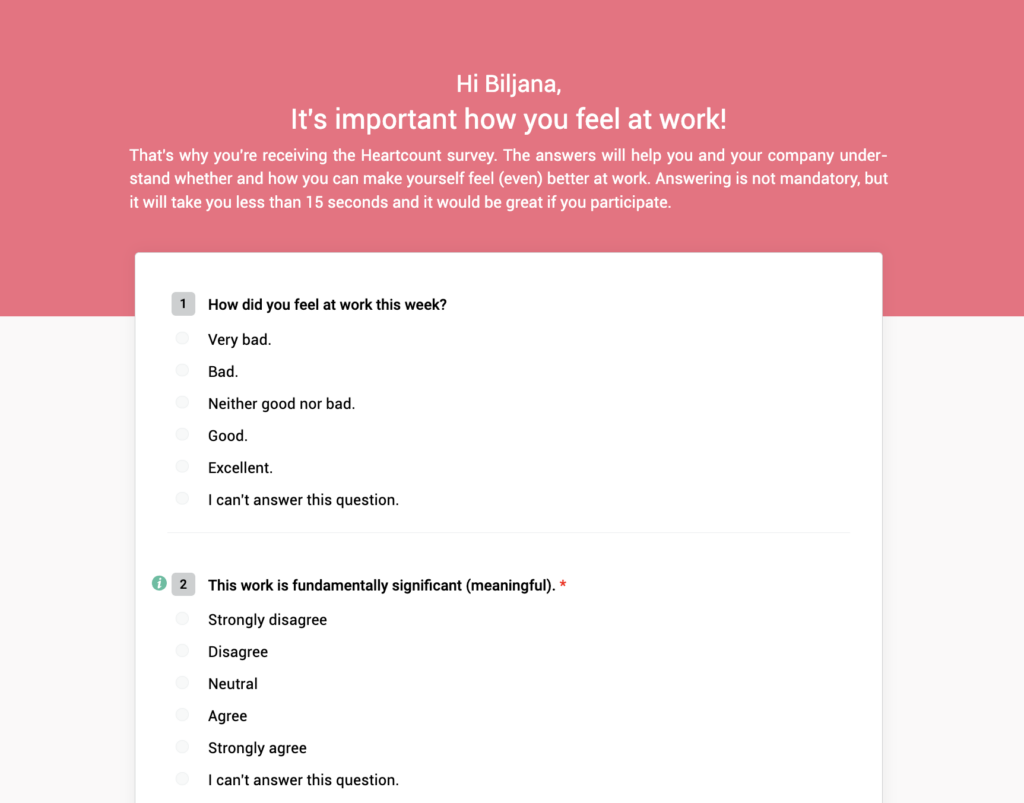
Make giving feedback easy
Short surveys with clear multiple-choice answers and anonymous open-ended sections are ideal. This encourages participation and honest responses.
Also, don’t forget employee praises. When people feel good about their work environment they are more likely to give kudos to their colleagues.
HeartCount makes it simple for employees to engage in peer recognition and provides plenty of data about their sentiments.

Segment the data
Once you have your feedback data, categorize it by relevant employee groups.
For example:
- By department: sales, marketing, engineering
- Job level: entry-level, mid-level, senior
- Tenure: New hires, mid-career, veterans
Analyze the feedback within each group. Are there specific concerns or satisfaction areas that dominate in certain departments? Does sentiment differ between new hires and experienced employees? Segmenting helps you identify areas needing attention within specific employee groups.
Use employee sentiment analysis tools
Employee sentiment analysis tools help you gauge employees’ feelings and attitudes, identify potential issues early, and improve overall workplace satisfaction.
These tools help HR make data-driven decisions to enhance employee engagement, retention, and productivity by addressing concerns and fostering a positive work environment.
Employee sentiment tools often use advanced technologies like NLP and machine learning (ML):
- NLP can identify sentiment and even categorize emotions within your employee feedback data.
- ML algorithms analyze trends and patterns in your data over time. They can help you predict potential issues before they become significant problems.
The case study by Direct Media United Solutions is a good example of how you can use technology to monitor employee sentiment. This media company faced challenges in tracking employee satisfaction using traditional surveys.
To address this issue, they used HeartCount, which provides weekly insights into employees’ feelings and thoughts. This approach allowed management to quickly identify and support employees needing additional attention, improving internal communication and overall business culture, especially during the shift to remote work.
HeartCount enabled timely interventions, fostering a supportive and proactive work environment.
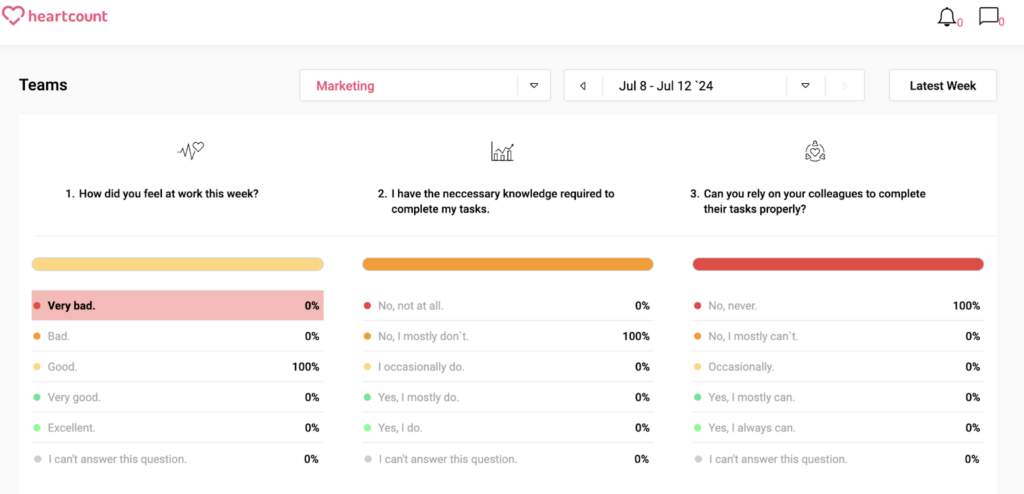
Act on feedback
Once you understand the feedback, address it. Communicate a plan to employees to show them you’re listening and build trust.
Based on employee sentiment, take action on the most pressing issues. Taking action demonstrates your commitment to improving their experience.
Be consistent
Measuring employee sentiment shouldn’t be a one-time thing. You should regularly conduct employee listening to see if things are improving or if new issues arise. Tracking sentiment over time will help you gauge the effectiveness of your changes.
Hearts are what counts
Positive employee sentiment boosts engagement, productivity, and retention. However, you will need all available help to gauge and interpret it accurately.
This is where HeartCount steps in.
Our powerful employee sentiment tool offers the following:
- Anonymous and confidential surveys that will encourage your employees to express their true feelings
- Special well-being engagement feature that includes the question “How did you feel at work this week?” in every pulse check survey
- Well-being score, a KPI that shows overall company and individual employee health
- Feedback pack with pulse checks, personal feedback, custom surveys, kudos, and private messages
- Weekly, semi-annual, and custom reports
Schedule a HeartCount demo and start a free trial today!







